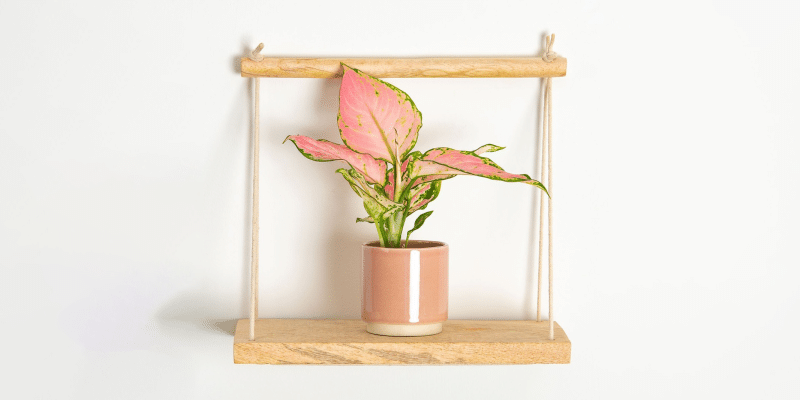While Chinese evergreen (or Aglaonema) may not be an actual conifer, they will confer a delicate and often colorful look to your home indoors.
(No more puns, we promise.)
There are so many species to choose from, each with its own unique look.
They’re both beautiful and easy to care for, and we’ll teach you all of the essentials in this growing guide, from propagation through the most common issues we see. We also have 20+ tips that cover humidity, watering frequency, and the correct soil to plant in.
Slow growth, low maintenance… we think you’re going to love this plant.
Table of Contents
Chinese Evergreen Care Guide
History, habitat, and characteristics

The Chinese evergreen (Aglaonema) is a fantastic houseplant that has been popular for… really, centuries. While it originated in tropical Southeast Asian forests, its unique selection of looks and ease of care has made it popular throughout the world as an indoor plant.
Each of its 20+ species has its own leaf pattern and colors that range from light to dark green, white, yellow, pink, red… did we miss any? There’s really a Chinese evergreen for every taste and interior palette.
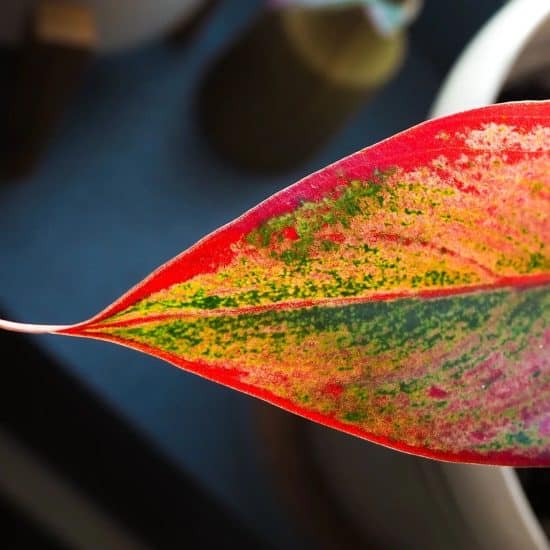
Contrary to its name, the Chinese evergreen is not an evergreen conifer, but rather a tropical plant that is a member of the same Araceae family as the peace lily and philodendron. With its slow-growing nature, this indoor beauty promises longevity and ease of care without taking up too much space in your home.
If you’re a beginner indoor gardener or someone looking for a low-maintenance houseplant with elegant beauty and natural air-purifying abilities, the Chinese evergreen is perfect for you.
Varieties

This plant has lots of varieties and names, like the Philippine evergreen and poison dart plant. So which variety should you pick?
The answer starts with what kind of plant you really want in your house, and it’s totally valid to just pick the prettiest plant that strikes your fancy and then find a place that works for it after.
With variegated plants, you can think about how much light your plant will need. If you have a house with lower light conditions, maybe pick a greener plant that’s more efficient at extracting those valuable photons.
Some of the most popular Chinese evergreen varieties include:
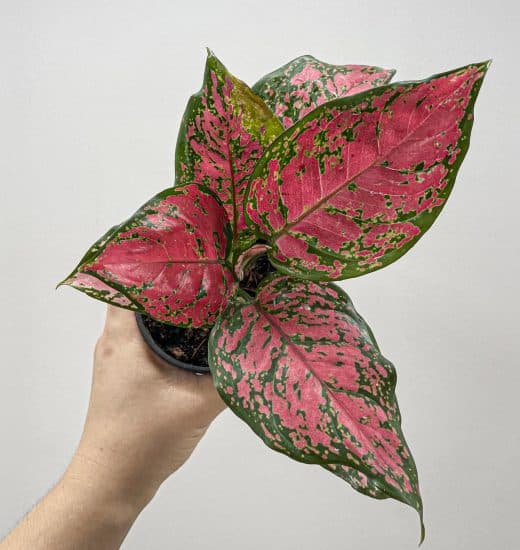
Aglaonema Lady Valentine (Pink Aglaonema): You’ll see this Chinese evergreen described by many names, but what they all have in common are green-bordered leaves with pink splashes (sometimes more than splashes) throughout the center. They feature lush green stems and need lots of light.

Aglaonema Maria: A darker green variegated Chinese evergreen, the “Maria” stays pretty compact and grows slowly.
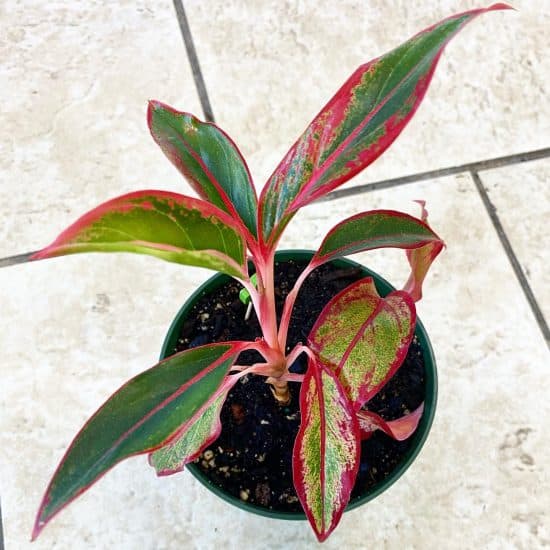
Aglaonema Aurora: Almost an inverse of the Pink Aglaonema, this Chinese evergreen “Aurora” has a beautiful pink midrib along with pink margins and stem.

Aglaonema Pictum Tricolor: If you can’t see the above picture of the Tricolor… maybe it’s a bit too camouflaged. Sorry! Beautiful, oval, spotty leaves in light and dark green with bits of white.

Silver Queen: An elegant variegated Chinese evergreen with beautiful silvery grey patterns.

Silver Bay: Often features even more of a grey-ish green look than the Silver Queen, with a light midrib and silvery veins.
Light

With lighting conditions, we start by asking ourselves: where does the Chinese evergreen thrive in nature, and how can we recreate its natural habitat?
Growing in the tropical subtropical forests of Thailand, close to the floor, we know that it’s going to want a location that doesn’t get too much direct sunlight.
Next, inspect how much variegation your Chinese evergreen has. With more variegation, it’ll require more bright indirect sunlight. If you have a variety with dark green leaves, it typically can tolerate low light a lot better.
More light means faster growth, too, so consider what kind of plant you want in your home. With a massive plant, you’ll really want to pour on that bright indirect light.
Lighting tips:
- Avoid direct sunlight, which will make leaves look faded and sun-bleached, and small holes will start to appear throughout your leaves.
- While the Chinese evergreen plant tolerates low light, if it sits in poor light for too long, it’ll lose its variegation, and you’ll see slow, leggy growth.
- If you want to encourage faster growth, consider adding an artificial light (ideally LED, full spectrum).
Water

Chinese evergreen plants are pretty easy to water, however it’s absolutely essential that there isn’t excess water. This plant really doesn’t like its roots to remain wet, and you’ll want to let it dry out even more in the winter, as it will take up water more slowly.
When we mention “less water,” this always means frequency. You can water these thoroughly until water drains through the soil. You’ll ideally treat them like a pour-over coffee, really slowly saturating the soil until it rises up, then waiting for it to settle again.
So when should you water? You’ll want to feel the soil an inch or two down and make sure it’s approaching dry. What does approaching dry mean?
You’ll kind of know it when you feel it.
You don’t want it to feel completely warm and loose, but it shouldn’t be moist or heavy. If you’re not sure, err on the side of less water and really let it dry completely to the second knuckle on a finger.
Not enough water will look like the oldest leaves on your Chinese evergreen – these are the bottom-most ones – turning bright yellow. Each stem may get one or two leaves like this, and if this is what you notice, you’ll want to increase how frequently you water this plant and pull off any dying leaves so they don’t become food for pests. You may also notice the leaves curling up.
Too much water can look like yellowing leaves throughout, mushy stems, and soil that remains moist. If you start to see brown leaf tips followed by small brown and black spots on the leaves, you likely have root rot (we’ll cover this in our last section below) and really need to cut back on the watering frequency. Let that soil dry out first.
Lastly, in the winter when your plant is growing a bit more slowly, you can cut back on how often you water.
Temperature and humidity
Hitting the right temperature and humidity is essential for Chinese evergreen care. As a tropical plant, it does tend to prefer higher temperatures and a humid room, but it can do just fine in normal household conditions.
Temperature should be between 60-80 degrees. If you buy your plant in the winter, you’ll want to ask the shop to wrap it in a bit of insulation or paper. A Chinese evergreen doesn’t like being shocked in very cold temperatures (think: below freezing). If you take it home in the winter and notice the leaves have tiny holes, this might be the cause.
Cold drafts aren’t too much of an issue for Chinese evergreen. It doesn’t want to be near an open window if it’s snowing out, but a normal draft should be fine. Similarly, air conditioners don’t seem to bother it too much.
If you do place it above a radiator, just make sure to supplement humidity so it doesn’t dry out.
For humidity, Chinese evergreen does grow a lot faster with higher levels. Normal household levels should be fine, but under 35%, you’ll start seeing brown leaf tips and other signs of being underwatered and dry.
You can raise humidity by:
- Grouping several plants together. When you do this, the water that evaporates from their leaves helps provide a microclimate through something called transpiration.
- Adding a small humidifier. I have a few of the cool mist humidifiers, which work great and don’t use too much electricity.
- Placing your plant on top of a pebble tray. You’ll fill a small tray with rocks and water to cover them. As it evaporates from the increased surface area, the local humidity should raise between 5-10%.
Soil and planting
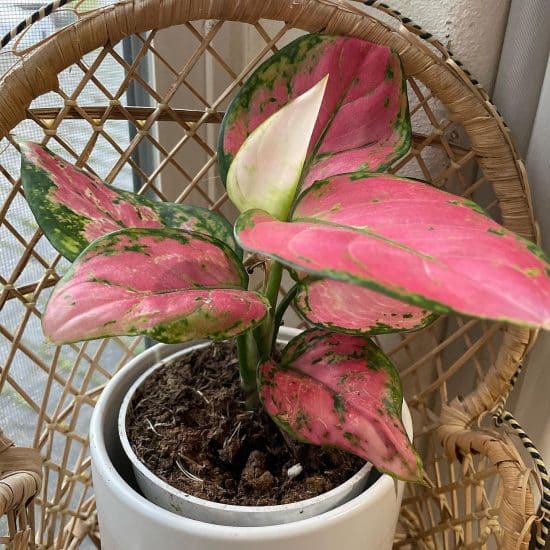
Chinese evergreen (Aglaonema commutatum) prefers well-draining soil. We recommend a mixture of regular potting soil and perlite.
Perlite (or pumice) is fantastic, as it’s a very light, porous volcanic rock. Because it’s formed at very high temperatures, it expands rapidly, giving it a high surface area. This means it not only helps retain water, but adds aeration to your soil, exactly what a Chinese evergreen wants.
Chinese evergreen is happy in a self-watering container, too. Make sure to let the container dry out completely in the winter every month or so for at least a day, as this plant wants to go dormant to conserve its energy during this period of lower light.
Repotting

When you get your Chinese evergreen home, it doesn’t need to be repotted right away. Wait a few months after getting it, unless you see roots really pouring out of the pot. Being repotted every 2-3 years is fine – your Aglaonema plant enjoys being a bit root bound.
You’ll want to make sure your pot does have drainage holes – they’re essential. Don’t let this plant sit in standing water.
When repotting, you can go one or two sizes up, and even pick a large container if you want it to grow faster and wider. If you’d rather keep your plant small, keep its pot small too.
We can’t stress this enough: proper drainage is essential for this plant – really make sure water has a way out of the pot and that the soil isn’t too compacted or wet.
Pruning
Similarly, pruning helps keep a plant small in two ways: not only does it remove leaves right away, immediately making the plant smaller, but it also encourages growth along dormant stem nodes, making your plant bushy instead of tall/wide.
When a stem is cut, it removes auxin from the plant, a hormone that governs which nodes it will grow on. When you decrease auxin, you’re promoting growth along all of those stem nodes down from the cut.
When you prune, cut in between two leaves/nodes. You can propagate from these later if you want. New stems will appear where you pruned.
It’s better to prune in the growing season of spring and summer if you want new growth. If you just want to cut it back, any time of the year is fine.
Fertilizing
You can apply a liquid balanced fertilizer every month or two when you see active growth. Keep in mind that too much fertilizer can cause leaves that look burnt, and you’ll need to fully flush the soil with water if you notice this.
I always dilute my fertilizer a bit more than the bottle says, and it’s best to start with less rather than more.
Propagation guide

Propagating Chinese evergreen is super easy, and great if you’re looking to expand your indoor plant collection, prune back an unruly beast, or just make new plants for friends.
(Or new friends through plants!)
Two main methods we’ll cover are: plant division and water propagation.
Propagating Chinese evergreen in water

If you prefer having more control over which part of the plant you want to propagate, stem cuttings are great. This method works throughout the year, and you can grab quite a few plants from one stem. If you don’t have several mature plants in your pot, this is also a great method because you won’t need to wait.
- Select a healthy stem from your Chinese evergreen.
- Cut the stem just below a leaf node, making sure it has at least 4-5 healthy leaves.
- Remove any leaves on the bottom two inches of the stem, as this will go into water.
- Place your stem in a jar of water, and put that jar in a brightly lit location. You can optionally cover the jar with a clear container or bag to help keep humidity high.
- Within a month (usually 3-4 weeks), you should see roots forming. Once they reach 2 inches, repot in a small pot in the potting soil/perlite mix.
- Water your baby plant frequently and keep humidity and light levels high as it matures.
Propagating Chinese evergreen through division
You can propagate Chinese evergreen through division if you have a few healthy plants in your pot. This method is great because you are working with mature plants that don’t need special care after being repotted. If you’re dreading sizing up your mother plant pot, this works great as a way to postpone repotting.
- Gently knock off the pot from your Chinese evergreen plant. You can tug down on it, or just give it a thwap! if you’re feeling playful.
- Take a look at the root system and look for a plant on the edge of the soil that’s healthy and able to be separated.
- Using gloves, pry away this plant gently, untangling the root ball as you go. You can pour water to assist with this, or cut away if it’s just a few tangled roots.
- Place each plant in separate pots, watering both and making sure the roots are buried under the soil. Normal Chinese evergreen care applies from here!
Propagation tips:
- Wear gloves to protect your hands from any sap, which can be irritating.
- Make sure your tools are sharp and sterilized. A sharp knife does less damage to your Aglaonema plant, and sterilized shears make sure you aren’t introducing any fungus or bacteria.
- Be patient! With water propagation, it can take a few weeks before you’ll see new roots forming. Don’t worry – they’ll come.
Common issues
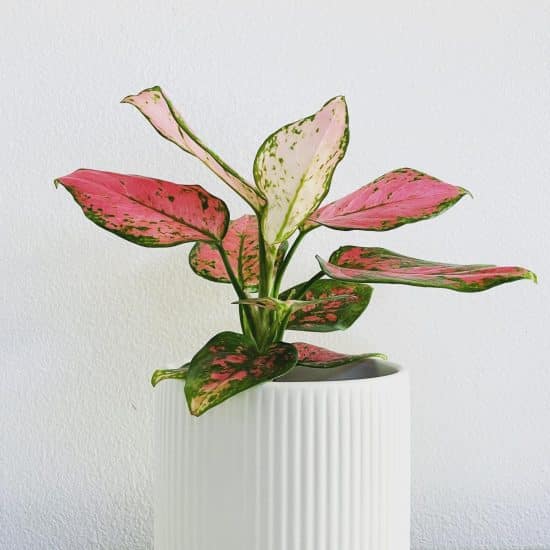
You’ve picked one of the easiest-to-care-for plants in the Chinese evergreen, but issues can still occur in any houseplant.
We’ll cover the most common issues we see, along with how to fix them.
Yellowing leaves
If your Chinese evergreen’s leaves are turning yellow, this is often due to overwatering, especially if the soil feels moist when you check it.
This plant does like regular watering during the growing season, but waterlogged soil can lead to root rot and a lot of issues for this plant. You’ll want to check our next section on rot if you suspect overwatering is the cause.
It could also be underwatering if it’s just the mature, lowest leaves that are turning yellow. Again, check the soil and let that guide you. If the soil is dry, the leaves look a bit wrinkly, and the stems don’t feel soggy or rubbery, it’s time to water.
Brown leaf tips

If the tips of your plant’s leaves have turned brown, it could be due to underwatering. Make sure the soil is evenly moist to prevent this issue from occurring. If you’re sure that the soil is damp enough, the problem may be due to low humidity levels.
Place a humidifier nearby or a tray of water close to the plant to increase humidity, or add a pebble tray.
If the tips are soft and wet, this could also be a sign of too much water. You’d expect to see spots along the leaves as well over time. Dry and crunchy? Not enough water.
Slow growing plant
If your Chinese evergreen isn’t really growing, it’s often a mixture of issues: low light, low humidity, or not enough nutrients in the soil.
You’ll want to address all three.
Start by using a balanced liquid fertilizer from spring through fall. You can use it monthly or every other month, making sure to dilute it.
Next, increase the amount of light your plant is getting, Lots of bright indirect light will really let this plant flourish.
Finally, you’ll want to increase the humidity. (We have plenty of tips for doing this in the humidity section above.)
Diseases and pests

While growing Chinese evergreen, it’s actually pretty unlikely that you’ll see any real issues with pests, but we’ll cover what to do if they (or other issues) do emerge.
Don’t feel like you’ve failed: this is something that anyone taking care of an indoor plant deals with at some point. If you’re facing a new issue, try to think of it as an opportunity to not just learn about what this plant needs, but to gain new knowledge!
Root rot
Root rot occurs when the roots are soaked for an extended period of time, causing them to rot. You can identify this by wilted and yellow leaves, or by the stalks dropping from the plant.
If you suspect root rot, remove the plant from its pot and inspect your roots. They should look white or creamy white, like… sprouts on healthy mung beans? If they’re dark or slimy, this is a sure sign you have root rot.
To fix:
- Remove your plant from its pot and trim off any mushy/rotting roots used sharp, sterilized shears.
- Place your old pot in the sun for a few weeks to let it be disinfected with UV. Dispose of the soil.
- Repot into fresh, well-draining soil, and reduce your watering frequency. Add perlite or pumice to the potting soil to make sure it’s able to dry out, and make sure your new pot has drainage holes so excess water can escape.
Pests

Scale, mealybugs, and spider mites are the pests we see more frequently in our Chinese evergreen plants. Some Aglaonema species do have large leaves, so it might be quite an infestation by the time you notice.
With scale or mealybugs, neem oil applied every few weeks does the trick. Keep reapplying until the pests are evicted, and make sure to keep your plant separated from the rest of your collection as you treat it.
With spider mites, you might notice little red dots, or just their webbing. You typically can’t see them until there are too many to count (millions), but they’re pretty easy to get rid of. You really can just spray the plant down with water (hose/shower) daily for the next few weeks. Mites hate water.
If you still have an issue, neem oil or soapy water both work great too.
Conclusion

You’ve reached the end of our Chinese evergreen care guide! Hailing from the tropical and subtropical forests of Asia, Aglaonema are surprisingly easy to grow indoors.
Remember that indoor gardening involves growth. Not just your plants… but of you! It can be a bit difficult or intimidating, and if this is the first plant you’re trying to care for, I really want to applaud you for giving it a go.
You got this! And if you need a reminder…
Our Chinese evergreen care summary:
- This plant likes being slightly root bound, so just go up one or two sizes when repotting.
- Plant in fresh soil with orchid bark, perlite, or pumice to help prevent root rot.
- You can propagate Chinese evergreen via root division (great for crowded pots) or stem cuttings.
- As the plant matures, it’s natural to lose a few leaves from the bottom. If you notice bottom leaves turning yellow, this could be a sign of not enough water.
- If you’re losing variegation and seeing all green leaves, this is a sign your plant needs more light (just make sure it’s not direct light, as this can burn the plant).
Hopefully, this was a helpful guide for you. If so, please let a friend know about it or drop us a line on Facebook or Twitter. Similarly, if you have any questions or pictures to share, get in touch. As always…
Take care!
FAQ
Should you mist a Chinese evergreen?
It’s better to use a wet cloth to wipe off its leaves. Misting doesn’t help with humidity, but wiping them off can keep the leaves in their best condition (dust-free) to take in light, and it’s a good opportunity to check for pests. Wiping off leaves even helps remove some pests like mites that hate moisture and attention.
Are Chinese evergreens toxic or safe for pets?
According to the ASPCA, these plants are toxic and contain calcium oxalate crystals that are dangerous if ingested, causing some swelling or even illness. You’ll want to keep this plant away from pets or small children. Its sap can also irritate your skin, so just be careful during cutting or handling: wash your hands immediately after or use gloves.
Does Chinese evergreen flower?
Chinese evergreen does produce flowers, but honestly… they’re nothing to write home about. This is a plant appreciated for its lush, intricate foliage and ease of care.
You may see these flowers once or twice a year, which is a great sign of a healthy plant.

